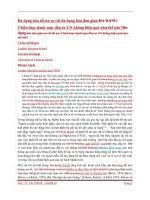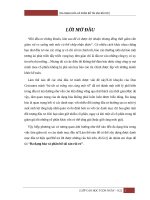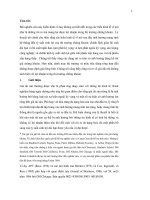Tiểu luận môn đầu tư tài chính the monetary policy and
Bạn đang xem bản rút gọn của tài liệu. Xem và tải ngay bản đầy đủ của tài liệu tại đây (2.06 MB, 50 trang )
The Monetary Policy and
Aggregate Demand Curves
Chapter 21 - The Monetary Policy and
Aggregate Demand Curves
Instructor :
Prof. & Dr. TRAN NGOC THO
Members of Group :
1.
2.
3.
TO THI THUY DAN
LE PHUONG ANH
LA BAO QUAN
Chapter 21
1.The Federal Reserve and Monetary Policy
2. The Monetary Policy Curve
3. Application
4. The Aggregate Demand Curve
5. Summary
PREVIEW
FED lowered the Federal Funds Rate by 75 basis points (0.75% point), moving the Federal Funds Rate almost all the way
to zero.
To see how a monetary policy action like the one above affects the economy, we
need to analyze HOW MONETARY POLICY AFFECTS AGGREGATE
DEMAND ?
Start this chapter by explaining :
WHY MONETARY POLICYMAKERS SET INTEREST RATES TO RISE WHEN INFLATION INCREASES ?
REAL INTEREST
RATES
IS CURVE (IS)
MONETARY POLICY CURVE (MP)
INFLATION
The Aggregate
Discuss short-run economic
Demand Curve
(AD)
fluctuations
THE FEDERAL
RESERVE AND
MONETARY POLICY
PART 1
One of primary policy tool
CENTRAL BANKS
Short-term Interest Rate
One of primary policy tool
FEDERAL RESERVE
FEDERAL FUNDS RATE
FED controls Federal Funds Rate by varying the reserves, it provides to the banking system.
Banks have more money to lend to each
More Reserves
Less Reserves
other
Banks have less to lend
Excess liquidity
Shortage of liquidity
Fed rate fall
Fed rate rise
Fed rate is a nominal interest rate, but we learned in the previous chapter it is the real interest rate that affects net
exports and business spending, thereby determining the level of equilibrium output.
How does the Federal Reserve’s control of
the Fed rate enable it to control the real
interest rate, through which monetary policy
impacts the economy ?
(1)
r : real interest rate
i : nominal interest rate
: expected inflation
(1)
Changes in nominal interest rates can change the real interest rate only if actual and expected inflation
remain unchanged in the short run.
Fed lowers the Fed rate real interest rates
Fed raises the Fed rate real interest rates
THE MONETARY POLICY CURVE
PART 2
The monetary policy (MP) curve indicates the relationship between the real interest rate the central bank sets and the
inflation rate.
: real interest rate
: autonomous component of the real interest rate
: responsiveness of the real interest rate to the inflation rate
Example :
= 1.0
= 0.5
MP :
(2)
At point A, where inflation is 1%, FED set the real interest rate at 1.5%
At point B, where inflation is 2%, FED sets the real interest rate at 2%
At point C, where inflation is 3%, FED sets the real interest rate at 2,5%
The line going through points A, B and C is the monetary policy curve MP
MP is upward – sloping.
Monetary policymakers raise real interest rate when the inflation rate raise.
WHY THE MONETARY POLICY CURVE HAS AN UPWARD
SLOPE ?
THE TAYLOR PRINCIPLE
THE TAYLOR PRINCIPLE
The monetary policymakers raise nominal rates by more than any rise in expected inflation
so that real interest rates rise when there is a rise in inflation.
In which higher inflation results in higher real interest rates.
What would happen if monetary policymakers instead allowed the real interest rate to fall when inflation rose ?
An increase in inflation would lead to a decline in the real interest rate, which would increase aggregate output, in turn
causing inflation to rise further, which would then cause the real interest rate to fall even more, increasing aggregate
output.
Inflation would continually keep rising and spin out of control
This is exactly what happened in the 1970s, when
the Federal Reserve did not raise nominal interest
rates by as much as inflation rose, so that real
interest rates fell.
Inflation accelerated to over 10%
Shift in the MP Curve
In common parlance, the FED is said to tighten monetary policy when it raises real interest rates, and to ease it when it
lowers real interest rates.
•
Changes in monetary policy that shift the monetary policy curve
Autonomous changes
along the monetary policy curve.
The Taylor principle-driven changes that are reflected as movements
to interest rates
•
Automatic adjustments
Autonomous changes
Autonomous tightening of monetary policy
•
Lower inflation they could increase by 1% point, and so raise the real interest rate at any given
inflation rate.
•
It would shift MP upward by 1% from to, thereby causing the economy to contract and inflation to
fall.
Autonomous easing of monetary policy
•
Monetary policymakers would want to lower real interest rates at any given inflation rate, in order
to stimulate the economy and also to prevent inflation from falling.
•
It would shift MP downward by 1% from to
Autonomous changes
Automatic adjustments to interest rates
A central bank’s normal response (also known as an endogenous response) of raising real interest rate when
inflation rise. These changes to interest rates do not shift the monetary policy cure, and so cannot be considered
autonomous tightening or easing of monetary policy.
Instead, they are reflected in movements along the monetary policy curve.
APPLICATION
PART 3
Autonomous Monetary Easing at the Onset of the
2007-2009 Financial Crisis
When the financial criris started in August 2007, inflation was rising and economic growth was quite strong. The FED
began an aggressive easing, lowering the FED rate as shown in Figure 3.
What does this tell us about effects on the monetary policy curve ?
A movement along MP curve would have suggested that the FED would continue to keep hiking interest rates because inflation was rising,
but instead it did the opposite.
The FED thus shifted
the MP down from
to
The FED pursued this autonomous monetary policy easing because the negative shock to the economy from the
disruption to financial markets indicated that, despite current high inflation rates, the economy was likely to weaken in
the near future and the inflation rate would fall.
THE AGGREGATE DEMAND CURVE
PART 4









